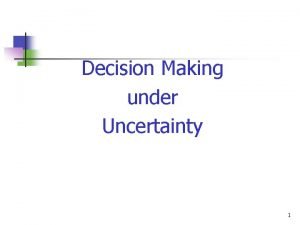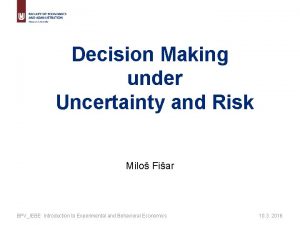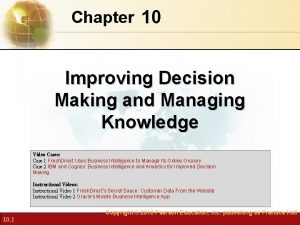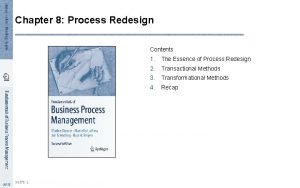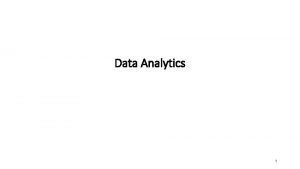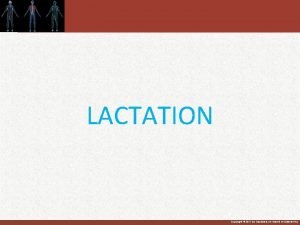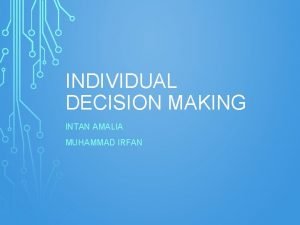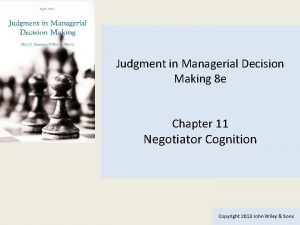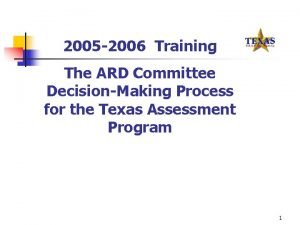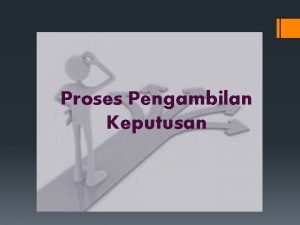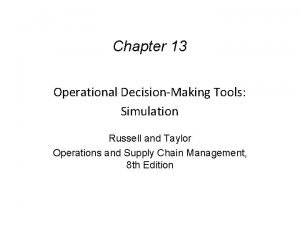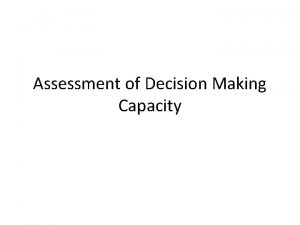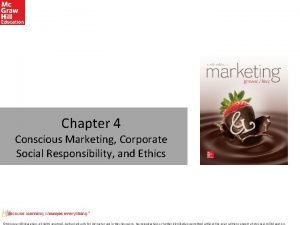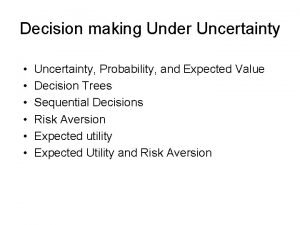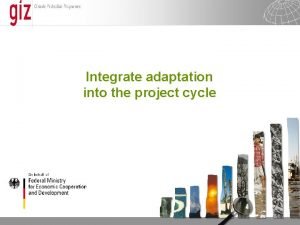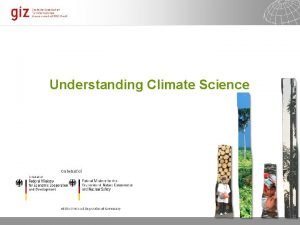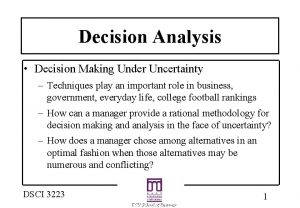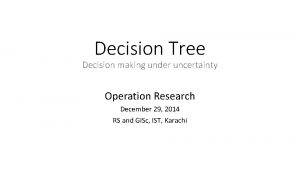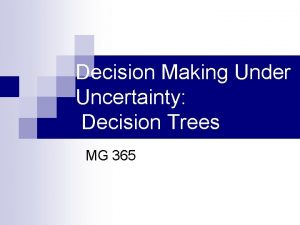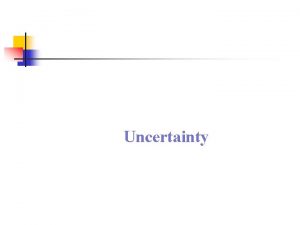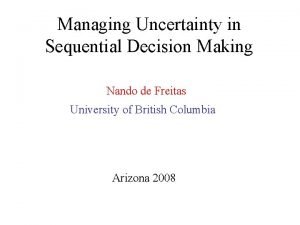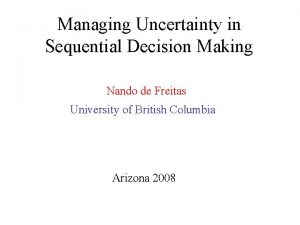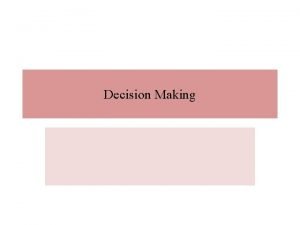Managing uncertainty in decision making Seite Imprint As




![Climate change: a management challenge § Responding to climate change impacts […] will challenge Climate change: a management challenge § Responding to climate change impacts […] will challenge](https://slidetodoc.com/presentation_image/db909407b16caf509b2c1c65b868d678/image-5.jpg)



























- Slides: 32

Managing uncertainty in decision making Seite

Imprint As a federally owned enterprise, GIZ supports the German Government in achieving its objectives in the field of international cooperation for sustainable development. Articles written by named authors do not necessarily reflect the views of the editors. Published by Deutsche Gesellschaft für Internationale Zusammenarbeit (GIZ) Gmb. H The training course ‘Integrating Climate Change Adaptation into Development Planning’ has been developed by the GIZ Climate Protection Programme, on behalf of the Federal Ministry for Economic Cooperation and Development (BMZ) Dag-Hammarskjöld-Weg 1 -5 65760 Eschborn, Germany T +49 61 96 79 -0 F +49 61 96 79 -1115 Contact E climate@giz. de I www. giz. de Responsible Michael Hoppe, GIZ Author Barbara Fröde-Thierfelder Coordination Barbara Fröde-Thierfelder This module has been elaborated as an addition to the existing training course on ‘Integrating Climate Change Adaptation into Development Planning’ with additional financing from BMU. Photo credits © GIZ/Climate Protection Programme and Claudia Altmann, Dirk Ostermeier, Florian Kopp, Georg Buchholz, Ira Olaleye, Jörg Böthling, Manuel Hauptmann, Markus Kirchgessner, Michael Gajo, Michael Netzhammer, Nicole Herzog, Peter Korneffel, Richard Lord, Robert Heine, Rüdiger Behrens, Ulrich Scholz, Ursula Meissner, Uwe Rau Design Ira Olaleye 06. 10. 2020 Seite 2 Page

Terms of use This training module has been developed by GIZ on behalf of BMU. If you would like to adapt this presentation to your needs, please respect the following terms of use: § The slide master and imprint are mandatory. They may neither be altered nor removed from the presentation. § The GIZ logo must not be moved or removed. No other logos or further information may be placed in the header or footer area. § If you wish to add your own content, please use the blank slide at the end of this presentation. (You can copy it to add slides. ) § If you would like to make substantial changes to the content of this presentation, please contact climate@giz. de. 06. 10. 2020 Seite 3 Page

Overview § Climate change: a management challenge § Uncertainties: the complex background of decision-making § Key elements strengthening governments’ capacity for adaptation decisions § Tools to manage uncertainty § Using scenarios in making decisions Case work § Reflection 06. 10. 2020 Seite 4 Page
![Climate change a management challenge Responding to climate change impacts will challenge Climate change: a management challenge § Responding to climate change impacts […] will challenge](https://slidetodoc.com/presentation_image/db909407b16caf509b2c1c65b868d678/image-5.jpg)
Climate change: a management challenge § Responding to climate change impacts […] will challenge decision makers at every level of government and in every sector. § In the choices policy makers must make, trade-offs will be necessary between the urgency of today‘s problems and the need to prepare for future risks. § However, integrating climate risks into governmental decision making will be essential if development and others goals are to be met. § National-level decisions play key roles in enabling local and privatesector adaptation efforts, especially by providing information and guidance. Source: World Resources Report (2011) 06. 10. 2020 Seite 5 Page

Dimensions of uncertainty -1 a § Basis of understanding – limited understanding of complex systems Source: RH Moss et al. Nature 463, 747 -756 (2010) 06. 10. 2020 Seite 6 Page

Dimensions of uncertainty -1 b § Basis of understanding – limited understanding of complex systems – validity of data input and interpretations IPCC guidelines for consistent evaluation and communication of uncertainties: Confidence in a finding = evidence + agreement Source: Maestrandrea M et al (2011) 06. 10. 2020 Seite 7 Page

Dimensions of uncertainty -1 c § Basis of understanding – limited understanding of complex systems – validity of data input and interpretations IPCC guidelines for consistent evaluation and communication of uncertainties: Confidence in a finding = evidence + agreement Likelihood Source: Maestrandrea M et al (2011) 06. 10. 2020 Seite 8 Page

Dimensions of uncertainty -1 d § Basis of understanding – limited understanding of complex systems – validity of data input and interpretations – inherent uncertainty 06. 10. 2020 Seite 9 Page

Dimensions of uncertainty -2 Variability between different model outputs per scenario § Basis of understanding – limited understanding of complex systems validity of data input and interpretations § Emission development – the extent of change in the atmosphere Variability between emission scenarios Source: http: //www. epa. gov/climatechange/science/images/ipcc_scenario_prediction. gif 06. 10. 2020 Seite 10 Page

Dimensions of uncertainty -3 § Basis of understanding – limited understanding of complex systems; validity of data input and interpretations § Emission development – the extent of change in the atmosphere § Impacts and vulnerability – effects of climate change – what are successful measures to prevent increased vulnerability Source: IPCC 2007 06. 10. 2020 Seite 11 Page

Uncertainties: the complex background for decision-making § Scientific analyses –the validity of data input and interpretations as basis for decisions § Emission development – the extent of change in the atmosphere § Impacts and vulnerability – effects of climate change – what are successful measures to prevent increased vulnerability Source: World Resources Report (2011) 06. 10. 2020 Seite 12 Page

High confidence = low uncertainty HIGHER >> >> >> >> LOWER Climate signal Temperature Precipitation General Trend of change Magnitude of change Scope Average values Variability Extreme events Timing Yearly Long-term Seasonal Short-term Scale Global Local Example Global annual mean temperature Local precipitation during next harvest season 06. 10. 2020 Source: based on UKCIP (2003): Climate Adaptation: Risk, uncertainty, decision-making. The confidence levelof projections Seite 13 Page

Uncertainty: Consequences for decision-making Over-confidence in unreliable information Unwillingness to decide and act Inefficient and unsystematic action Maladaptation Misinvestments Conflicts 06. 10. 2020 Seite 14 Page

Today’s decisions shape the future Source: Stafford Smith et al. (2010) 06. 10. 2020 Seite 15 Page

Characteristics of effective decision making approaches § Responsive: react quickly § Proactive: prepare for impacts § Flexible: learn and re-adjust § Durable: embrace long time horizons § Robust: relevant for different futures Source: World Resources Report (2011) 06. 10. 2020 Seite 16 Page

Key elements strengthening governments’ abilities for adaptation decisions § Public engagement in order to § Define adaptation needs § Prioritize and select options § Define acceptable levels of risk § Decision-relevant information, i. e. § Accurate, accessible, updated, costeffective § Available = Collected and distributed § Tools for planning and policymaking, i. e. § Risk / vulnerability assessments §Decision support tools § Resources, i. e. § Financial § Human § Ecological § Institutional design, i. e. § § Coordination: vertical and horizontal Leadership Clear mandates Integration into ongoing processes Source: World Resources Report (2011) 06. 10. 2020 Seite 17 Page

Steps in decision making Is XXX (climate change/ effects) sth we should deal with? Strategic What should we do? How should we do it? Who? When? Financing? Etc. . Operational 06. 10. 2020 Seite 18 Page

Tools for managing uncertainty in decision making/problem-solving § Everything relates to everything: lost between causes and effects? -> Systematic adaptation (needs) assessment § Decision basis unclear? -> Statistics Scenarios -> Triangulation -> Possibility ranges § Not enough information for decisions on adaptation activities? -> Work on decisions that are necessary now, go step by step -> Flexible strategies/corridors, adaptive management/M&E § Projections show disasters with tremendous effect but rather unlikely occurence? ->Contingency planning 06. 10. 2020 Seite 19 Page

? ? ? Introduction: What are scenarios § Scenarios are different plausible combinations of a set of circumstances and thus describe different future situations § Scenarios are NOT predictions § They help § to sensitise decision makers for factors influencing future development § to anticipate future threats and opportunities for development § to enhance collective learning and exchange § to - in due course - make decisions for activities (limit threats, secure against negative effects, enhance opportunities) NOW later 06. 10. 2020 Seite 20 Page

Exercise: 'Designing scenarios' Seite

Introduction: how to develop scenarios (linear) (1) Determine the question you want to deal with, (2) Determine influencing factors, that differ according to your decisions (3) Define different values for factors, (4) Combine factors/values (5) Describe plausible storylines 06. 10. 2020 Seite 22 Page

Introduction to the exercise Working time: 20 min in total! § Form buzzgroups of 3 -4 with your neighbors § Discuss steps 2 -4 for the given question § Factors § Values § Combination § Prepare a very short presentation on your approach for the plenary <2 min 06. 10. 2020 Seite 23 Page

Introduction: how to develop scenarios (linear): Example: Zanadu’s agriculture development (1) Determine the question you want to deal with, e. g. possible futures for agriculture in Zanadu (2) Determine influencing factors, that differ according to your decisions e. g. investments, political orientation low Investments in ACC high growth Development perspective growth balanced with resilience climate proof (3) Define different values for factors, e. g. high investments from global agro business players, development cooperation support combined with efficiency efforts in local governments and local taxes S 1: 'Growth and technology' middle reactive Political Orientation S 2: 'Balancing growth and resilience' S 3: 'Climate proof ' initiative proactive (4) Combine factors/values (5) Describe plausible storylines 06. 10. 2020 Seite 24 Page

Motivate decision making - formula for change Dissatisfaction w/ situation Vision = desirable future COST OF CHANGE / RESISTANCE Concrete steps how to get there 06. 10. 2020 Seite 25 Page

Case work 'Prepare a decision on the future of Zanadu’s agriculture' Seite

Source: GIZ 06. 10. 2020 Seite 27 Page

Exercise (1) Context § The Ministry of Agriculture has gained knowledge about climate change in Zanadu – and especially the impacts on agriculture. However, the directors are at an impasse with the decision on which policies and activities they should favour. § They have formed an expert task force (your group) to assist them in making a decision on the development pathway to plan for. § In a first step you have prepared 3 scenarios. Now you have to evaluate them against a set of criteria given by the Mo. A. Exhibits § Climate information for agriculture in Zanadu § 3 Scenarios 06. 10. 2020 Seite 28 Page

Exercise (2) Your task § Read the exhibits carefully § Evaluate the 3 scenarios against a set of criteria (matrix 1) § You have the chance to add a 4 th criterion – discuss and choose § Discuss how you want to approach the evaluation § Conduct and document the evaluation § Prepare your presentation at the Ministry (e. g. poster) § Prepare a convincing rationale for your decision § Recall the objective, criteria and selection process § Explain why you have selected scenario X (why the others don’t match) § If possible, give examples of what kind of activities and/or decisions this would require from the Ministry 06. 10. 2020 Seite 29 Page

Exercise (3) Results § Evaluation of 3 Scenarios § Presentation of findings Logistics § Case work (including reading time) – 80 min § Presentation of results (at the Ministry) – 10 min/group 06. 10. 2020 Seite 30 Page

Reflection § 1 st round § What is my take-home message? § 2 nd round § How can I improve my daily work through the newly acquired knowledge? § 3 rd round § What are the rules for communicating climate change in order to motivate action? 06. 10. 2020 Seite 31 Page

Title Text This slide is not part of the original version of the training material. It was added by [please insert institution]. 06. 10. 2020 Seite 32 Page
 Decision-making under uncertainty
Decision-making under uncertainty Uncertainity in decision making
Uncertainity in decision making Improving decision making and managing knowledge
Improving decision making and managing knowledge Dividend decision in financial management
Dividend decision in financial management Objectives of decision making
Objectives of decision making The redesign orbit
The redesign orbit Seite lschen
Seite lschen Schlusswort hochzeitszeitung lustig
Schlusswort hochzeitszeitung lustig Alfred kubin die andere seite
Alfred kubin die andere seite Managing uncertainty in supply chain safety inventory
Managing uncertainty in supply chain safety inventory Which decision model incorporates the uncertainty element
Which decision model incorporates the uncertainty element Imprint culture
Imprint culture Which disciple wanted to see the imprint of the nails
Which disciple wanted to see the imprint of the nails Imprint definition psychology
Imprint definition psychology Galactopoeisis
Galactopoeisis Thermal nil
Thermal nil Cultural imprint meaning
Cultural imprint meaning Step and flash imprint lithography
Step and flash imprint lithography In managing attractions, a programmed decision is
In managing attractions, a programmed decision is Decision table and decision tree examples
Decision table and decision tree examples Extended decision making
Extended decision making Mythical fixed pie assumption
Mythical fixed pie assumption Ard committee decision making process
Ard committee decision making process Disposition model of decision making
Disposition model of decision making 4 tahap pengambilan keputusan menurut simon
4 tahap pengambilan keputusan menurut simon Operational decision making tools
Operational decision making tools Tactical decision making adalah
Tactical decision making adalah Bok's model of ethical decision making
Bok's model of ethical decision making Defining moments
Defining moments Ethical decision making and ethical leadership
Ethical decision making and ethical leadership Competency and capacity
Competency and capacity Conscious marketing principles
Conscious marketing principles Unusual situations that have not been often addressed.
Unusual situations that have not been often addressed.
